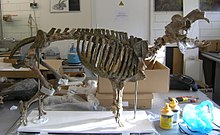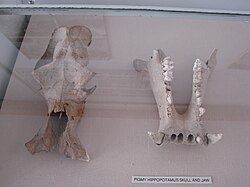
The hippopotamus, also shortened to hippo, further qualified as the common hippopotamus, Nile hippopotamus, or river hippopotamus, is a large semiaquatic mammal native to sub-Saharan Africa. It is one of only two extant species in the family Hippopotamidae, the other being the pygmy hippopotamus. Its name comes from the ancient Greek for "river horse" (ἱπποπόταμος).

Hippopotamidae is a family of stout, naked-skinned, and semiaquatic artiodactyl mammals, possessing three-chambered stomachs and walking on four toes on each foot. While they resemble pigs physiologically, their closest living relatives are the cetaceans. They are sometimes referred to as hippopotamids.

The pygmy hippopotamus or pygmy hippo is a small hippopotamid which is native to the forests and swamps of West Africa, primarily in Liberia, with small populations in Sierra Leone, Guinea, and Ivory Coast. It has been extirpated from Nigeria.

Aetokremnos is a rock shelter near Limassol on the southern coast of Cyprus. It is widely considered to host some of the oldest evidence of human habitation of Cyprus, dating to around 12,000 years ago. It is situated on a steep cliff site c. 40 m (131.23 ft) above the Mediterranean sea. The name means "Cliff of the eagles" in Greek. Around 40 m2 (430.56 sq ft) have been excavated and out of the four layers documented, the third is sterile.
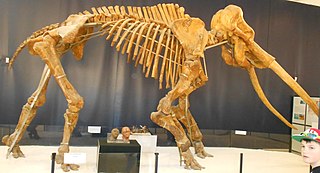
Palaeoloxodon is an extinct genus of elephant. The genus originated in Africa during the Early Pleistocene, and expanded into Eurasia at the beginning of the Middle Pleistocene. The genus contains some of the largest known species of elephants, over 4 metres (13 ft) tall at the shoulders, including the African Palaeoloxodon recki, the European straight-tusked elephant and the South Asian Palaeoloxodon namadicus. P. namadicus has been suggested to be the largest known land mammal by some authors based on extrapolation from fragmentary remains, though these estimates are highly speculative. In contrast, the genus also contains many species of dwarf elephants that evolved via insular dwarfism on islands in the Mediterranean, some only 1 metre (3.3 ft) in height, making them the smallest elephants known. The genus has a long and complex taxonomic history, and at various times, it has been considered to belong to Loxodonta or Elephas, but today is usually considered a valid and separate genus in its own right.

Dwarf elephants are prehistoric members of the order Proboscidea which, through the process of allopatric speciation on islands, evolved much smaller body sizes in comparison with their immediate ancestors. Dwarf elephants are an example of insular dwarfism, the phenomenon whereby large terrestrial vertebrates that colonize islands evolve dwarf forms, a phenomenon attributed to adaptation to resource-poor environments and lack of predation and competition.
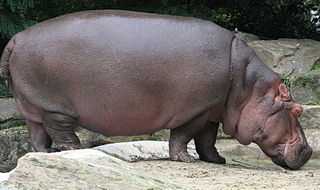
Hippopotamus is a genus of artiodactyl mammals consisting of one extant species, Hippopotamus amphibius, the river hippopotamus, and several extinct species from both recent and prehistoric times. It belongs to the family Hippopotamidae, which also includes the pygmy hippopotamus and a number of extinct genera.

Metailurus is a genus of saber-toothed cat in the family Felidae, and belonging to the tribe Metailurini, which occurred in North America, Eurasia and Africa from the Miocene to the Middle Pleistocene.
The Cypriot mouse is a species of mouse endemic to Cyprus. Its primary habitat seems to be the vineyards and fields of the Troödos Mountains region.

Hippopotamus antiquus is an extinct species of Hippopotamus that ranged across Europe during the Early and Middle Pleistocene.
Hippopotamus melitensis is an extinct hippopotamus from Malta. It lived during Middle-Late Pleistocene. It probably descended from Hippopotamus pentlandi from Sicily, which in turn probably descended from the common hippopotamus. Like Hippopotamus pentlandi, Hippopotamus melitensis is substantially smaller in size than H. amphibius as a result of insular dwarfism, having an estimated mass of approximately 900 kg, which is smaller than the 1100 kg estimated for H. pentlandi. The diet of H. melitensis is suggested to have been more generalist than Hippopotamus amphibius, likely as a result of limited resource diversity and lack of competition, as the only other large herbivore on the island was the dwarf elephant Palaeoloxodon mnaidriensis. The majority of findings of this species are from Għar Dalam, a cave on Malta famous for its Pleistocene fossil deposits.

Hippopotamus pentlandi is an extinct species of hippopotamus from Sicily, known from the late Middle Pleistocene to early Late Pleistocene. It is the largest of the insular dwarf hippos known from the Pleistocene of the Mediterranean, "at most 20% smaller than the mainland forms", with an estimated body mass of approximately 1100 kg. It is suggested that it arrived in Sicily between 250,000 and 150,000 years ago, probably descending from the modern hippopotamus, with an origin from Hippopotamus antiquus being less likely. In comparison to those species, the muzzle was shorter, the occipital and nasal regions were more developed, the mastoid process was enlarged, and the dental row was shortened, and the condyle of the mandible is low. In comparison to H. amphibius, the orbits are also elevated. It was present in Sicily until at least the latest Middle Pleistocene around 120 kya, and was probably extinct by the beginning of Marine Isotope Stage 4. Contemporaneous species include the dwarf elephant Palaeoloxodon mnaidriensis, the aurochs, red deer, steppe bison, fallow deer, wild boar, brown bear, wolves, red foxes, cave hyena and cave lions. Its diet was likely grazing dominated, similar to that of modern H. amphibius. It is probably ancestral to Hippopotamus melitensis from Malta, which is substantially smaller than H. pentlandi.

Several species of Malagasy hippopotamus lived on the island of Madagascar but are now believed to be extinct. The animals were very similar to the extant hippopotamus and pygmy hippopotamus. The fossil record suggests that at least one species of hippopotamus lived until about 1,000 years ago and other evidence suggests that the species may have survived until much more recently. The taxonomy of these animals is not resolved and not widely studied.

Palaeoloxodon cypriotes is an extinct species of dwarf elephant that inhabited the island of Cyprus during the Late Pleistocene. The species became extinct around 12,000 years ago, around the time humans first colonised Cyprus.
Hippopotamus creutzburgi, the Cretan dwarf hippopotamus, is an extinct species of hippopotamus from the island of Crete. It lived on the island from the Early Pleistocene to early Middle Pleistocene, and probably descended from Hippopotamus antiquus. It was considerably smaller than H. antiquus, weighing approximately 400 kilograms (880 lb). It was one of only two large herbivores on the island during its existence, alongside the dwarf mammoth Mammuthus creticus, with large predators being absent, the only other species of mammal present on the island being the giant rat Kritimys. It is known from abundant remains collected from the Katharo basin in the eastern uplands of Crete, approximately 1,100–1,200 metres (3,600–3,900 ft) above sea level, as well as much rarer remains found in coastal caves. Analysis of its limbs suggests that it was more adapted to terrestrial locomotion than living hippopotamus, primarily walking on its hooves rather than its footpads as in living hippopotamus, and capable of traversing the rugged terrain of Crete. Analysis of its teeth suggests that it had a grazing diet, similar to modern Hippopotamus amphibius. The previous suggestion that the species can be divided into two subspecies is not supported by modern research.
Hippopotamus laloumena is an extinct species of hippopotamus from Pleistocene and Holocene Madagascar, making it the oldest of Malagasy hippopotamus. H. laloumena was much larger than other Malagasy hippopotamus, but was still somewhat smaller than the common hippopotamus. However, little is known about the species because it was identified with only a lower jaw and limb bones. It was described in 1990 by French palaeontologists M. Faure and Guerin, the fossils recovered from a site near Mananjary on the east coast of Madagascar. The species name derives from Malagasy laloumena "hippopotamus".

The wildlife of Cyprus includes its flora and fauna and their natural habitats. Cyprus has a rich flora and a diverse fauna albeit with relatively few mammals. Like most modern countries, the natural habitats in Cyprus have been steadily disappearing, currently retaining only 20% of its original habitat due to rapid urbanization, usage of forests for commercial purposes, tourism and various other reasons. One of the features of Cyprus' habitats is the wild and sharp differences in elevations and habitats on the island as well as climate, all of which supply a diverse habitat for an array of fauna and flora. Terra Cypria was established as a trust in 1992 to conserve the Cypriot environment and its biodiversity.

Palaeoloxodon creutzburgi is an extinct species of elephant known from the Middle-Late Pleistocene of Crete. It is a descendant of the large mainland species Palaeoloxodon antiquus. It is known from localities across the island. P. chaniensis from Stylos and in Vamos cave, Chania, west Crete is considered to be a junior synonym of P. creutzburgi. It had undergone insular dwarfism, being approximately 40% of the size of its mainland ancestor, and was around the size of the living Asian elephant. It lived alongside the radiation of Candiacervus deer endemic to the island, the mouse Mus batae-minotaurus, the Cretan otter, and the Cretan shrew.
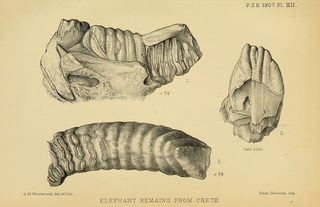
Mammuthus creticus, or the Cretan dwarf mammoth, is an extinct species of dwarf mammoth endemic to Crete.
Kritimys, also known as the Cretan giant rat is an extinct genus of murid rodent that was endemic to the island of Crete during the Early and Middle Pleistocene. There are two known species, K. kiridus from the Early-Mid Pleistocene, and its descendant K. catreus from the Middle Pleistocene. It is suggested to be closely related to and probably derived from Praomys. As with most island rodents, Kritimys was larger than its mainland relatives, with its size increasing over time, with K. catreus estimated to weigh 518 grams (1.142 lb), around 6.7 times the weight of its mainland ancestor, an example of island gigantism. The temporal range of the genus is considered to define the regional Kritimys biozone, during which time there were only two other species of mammal native to the island, a species of dwarf mammoth, Mammuthus creticus and the dwarf hippopotamus Hippopotamus creutzburgi. It became extinct during the late Middle Pleistocene, following the arrival of the Mus bateae-minotaurus lineage to the island, exhibiting a decrease in size shortly before its extinction.
